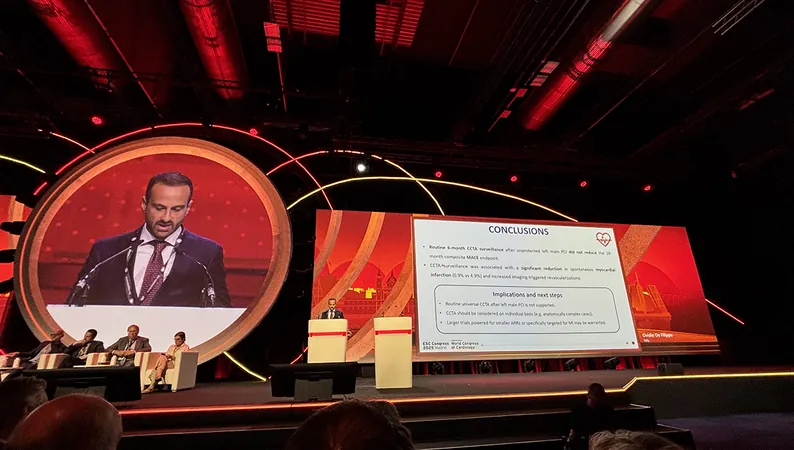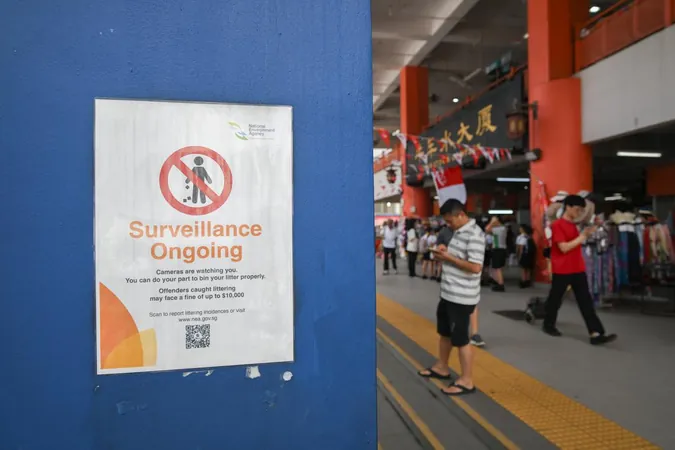
Routine CT Angiography After Left Main PCI: New Study Reveals No Benefits
2025-08-31
Author: Ming
The Latest Findings from the PULSE Trial
In a groundbreaking study presented at the European Society of Cardiology Congress 2025 in Madrid, researchers revealed that routine CT angiography following percutaneous coronary intervention (PCI) for left main coronary artery disease does not reduce the risk of serious cardiac events. These findings come from the PULSE trial, which adds to a growing body of evidence questioning the effectiveness of regular post-PCI imaging.
The Provocative MI Findings
While the study did hint at a potential decrease in myocardial infarction (MI) risk when CT angiography was performed at six months, this discovery is deemed more of a hypothesis than a definitive conclusion. Dr. Ovidio de Filippo, one of the principal investigators, emphasized that routine use of this imaging technique is unwarranted, assuring that not every patient post-PCI requires such follow-ups.
High-Risk Patients Under Scrutiny
The PULSE trial specifically targeted patients considered higher risk for post-procedure complications, and the results indicate that traditional follow-up guidelines may be insufficient. Current European standards recommend symptom-driven surveillance, while U.S. guidelines vary, offering only weak suggestions for post-PCI testing.
Study Cohort and Key Outcomes
Involving 606 participants with a mean age of 69, the trial tracked patients randomized either to undergo CT angiography or to receive care based on their symptoms post-PCI. Despite the extensive nature of the study, both groups exhibited similar outcomes in terms of severe complications over an 18-month period.
The Minor Benefit: MIs and Revascularization Rates
Interestingly, even though the overall rates of major adverse events were comparable—11.9% in the CT group and 12.5% in the control—MI occurrences were significantly lower in the CT group (0.9% vs. 4.9%). Nonetheless, Dr. Gregg Stone, who discussed the findings, cautions that these observations may be misleading, highlighting the study's limitations regarding sample size and the potential for chance findings.
Guidelines Under Question
The debate around routine imaging has been reignited, particularly considering contrasting trials like ISCHEMIA, which suggest that invasive strategies may not significantly benefit stabilized patients after left main PCI compared to standard medical therapy.
Final Takeaway
Overall, the PULSE trial's findings suggest that while curiosity persists around post-PCI imaging strategies, the evidence currently does not support routine CT angiography in most cases. As research continues, the medical community awaits clearer guidelines on the optimal post-PCI follow-up strategies, particularly for high-risk patients.




 Brasil (PT)
Brasil (PT)
 Canada (EN)
Canada (EN)
 Chile (ES)
Chile (ES)
 Česko (CS)
Česko (CS)
 대한민국 (KO)
대한민국 (KO)
 España (ES)
España (ES)
 France (FR)
France (FR)
 Hong Kong (EN)
Hong Kong (EN)
 Italia (IT)
Italia (IT)
 日本 (JA)
日本 (JA)
 Magyarország (HU)
Magyarország (HU)
 Norge (NO)
Norge (NO)
 Polska (PL)
Polska (PL)
 Schweiz (DE)
Schweiz (DE)
 Singapore (EN)
Singapore (EN)
 Sverige (SV)
Sverige (SV)
 Suomi (FI)
Suomi (FI)
 Türkiye (TR)
Türkiye (TR)
 الإمارات العربية المتحدة (AR)
الإمارات العربية المتحدة (AR)